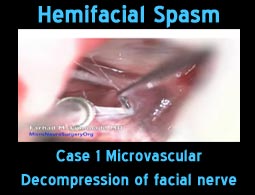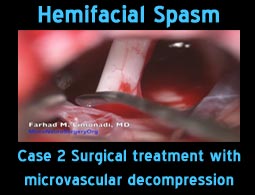Hemifacial Spasm Overview:
- Patients with hemifacial spasm experience intermittent, painless, spasm of muscles of the face, which is involuntary and limited to only one side.
- The spasm and twitching may be limited to upper or lower half of the face only and eventually involve the entire half of the face.
- This condition usually begins with rare twitching of muscles around one eye, and slowly progresses to involve the entire half of the face with increasing frequency and intensity.
- In some cases patients may also experience excessive lacrimation.
- Hemifacial spasm is commonly caused by compression of the facial nerve by AICA (anterior inferior cerebellar artery) at the root exit zone of the facial nerve.
- Hemifacial spasm is generally a surgical condition with anticonvulsants such as carbamazepine and phenytoin being ineffective unlike trigeminal neuralgia.
- Injection of the involved muscles with botulinum toxin may be effective in treating this disease temporarily.
- Microvascular decompression of the facial nerve is the definitive treatment during which the offending vessel is dissected off the facial nerve and a thin strip of Teflon felt acts as a cushion between the facial nerve and the vessel compressing it.
- The success of microvascular decompression does depend on the duration of the symptoms with shorter duration resulting in better outcomes.
- The surgical technique of microvascular decompression (MVD) for hemifacial spasm is similar to MVD for trigeminal neuralgia. Please look at the trigeminal neuralgia segment for more information about MVD.
Hemifacial Spasm Cases:




















